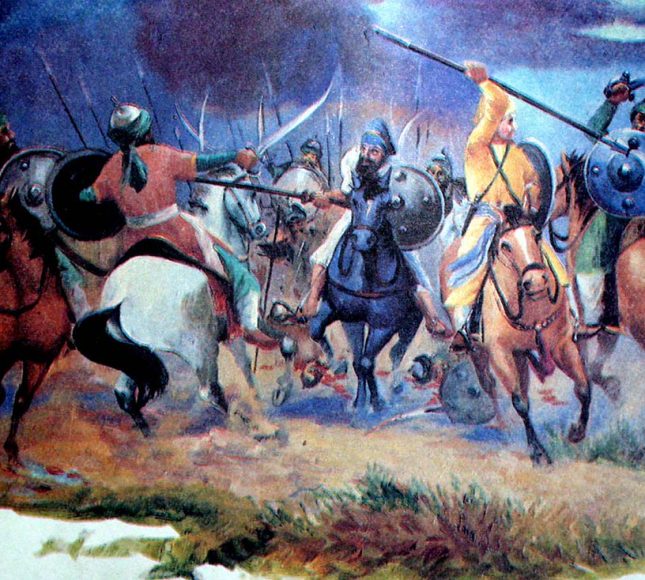ANANDPUR DI VAR is a versified account in Punjabi, by one Ram Singh, of a battle fought in 1812 between Sodhi Surjan Singh of Anandpur and Raja Maha Chand of Kahlur. Sodhi Surjan Singh was a lineal descendant of Suraj Mall, a son of Guru Hargobind. His father, Nahar Singh, who was a brave and influential person, had established an independent state by force of arms. Surjan Singh, too, was a man of prowess and was increasing his area of influence. Maha Chand, the chief of the neighbouring state of Kahlur, was jealous of the growing power of Surjan Singh, whom he considered no more than a vassal of his.
He sent word to him demanding land revenue. The Sodhi refused, saying that he was an autonomous ruler in his territory. Raja Maha Chand led a force against him, and a fierce battle ensued. The poem describes the action in some detail. Surjan Singh received help from Sardar Hukma Singh, about whose identity no exact information is supplied by the poet.
The invading troops were defeated and they fled, leaving a large number of dead on the field. According to the poet, Bhai Sukkha Singh, author of Gurbilas Dasvin Patshahi, and Bhai Mahna Singh, the Jathedar of Sri Kesgarh Sahib, took part in this battle. From the minute details of the combat and of the feats displayed by some of the contestants, the poet seems to have been an eyewitness to the whole campaign.
References:
- Ashok, Shamsher Singh, ed., Prachin Jang Name. Amritsar, 1950
Anandpur Di Var is a shining example of Punjabi literary tradition, weaving together history, valor, and art into a versified account of a pivotal battle fought in 1812. Composed by Ram Singh, this narrative poem stands not only as a historical document but also as an embodiment of the spirit and martial prowess that defined its era.
Historical and Political Context
At the heart of the poem is the confrontation between Sodhi Surjan Singh of Anandpur and Raja Maha Chand of Kahlur. Surjan Singh, a direct descendant of Suraj Mall (the son of Guru Hargobind), had inherited not only a legacy of martial valor but also the ambition to expand his autonomous territory. His father, Nahar Singh, had already established an independent state through military might, setting the stage for his son’s further expansion. Seeing the growing influence of Anandpur, Raja Maha Chand of Kahlur—jealous and intent on asserting his hegemony—demanded land revenue from Surjan Singh. The refusal to accept subjugation led to a fierce confrontation in 1812, as the Raja mobilized his forces to assert control over the strategically important Anandpur region.
Literary Craft and Eyewitness Detail
Ram Singh’s Anandpur Di Var is more than a mere recounting of military maneuvers—it is a meticulously crafted epic that captures minute details of the battle. The verses of the vaar illustrate both the tactical aspects of the conflict and the individual feats of courage that marked the encounter. Notably, the poem mentions key figures such as Sardar Hukma Singh, who lent his support to Surjan Singh, although his precise historical footprint remains somewhat veiled in mystery.
Furthermore, the narrative credits the participation of revered warriors like Bhai Sukkha Singh—known for later authoring significant Sikh historical works such as the Gurbilas Dasvin Patshahi—and Bhai Mahna Singh, the Jathedar of Sri Kesgarh Sahib. Their inclusion not only lends the poem authenticity but also bridges the martial and spiritual dimensions of Sikh heritage. The detailed descriptions in the verses suggest that Ram Singh might have been an eyewitness to the battle, offering a rare, vivid account of the valor and bloodshed that ensued.
Themes of Autonomy and Valor
Central to Anandpur Di Var is the celebration of autonomous rule and the refusal to bend under coercion. Surjan Singh’s defiant response to Raja Maha Chand’s demands is emblematic of the broader Sikh tradition of self-respect and independence—a recurring theme across many Sikh literary works. The victorious outcome for Surjan Singh’s forces, who repelled the invading troops leaving them with heavy casualties, is presented as both a military triumph and a moral lesson in resisting tyranny.
The poem’s martial imagery, evocative language, and rhythmic cadence served multiple purposes: it preserved the heroic episode for posterity, inspired future generations to valor and sacrifice, and reinforced a collective identity grounded in resistance against external domination.
Cultural and Scholarly Implications
Anandpur Di Var occupies an important place in the literary and cultural heritage of the Sikhs and Punjabis alike. As a work that straddles the domains of history and poetry, it provides contemporary scholars with rich material for understanding the interplay between oral tradition, textual transmission, and political narrative. The detailed account and vivid imagery not only highlight the battle strategies and valor of individual warriors but also serve as a cultural artifact that reflects the socio-political dynamics of early 19th-century Punjab.
Moreover, by capturing a moment when regional powers contended over sovereignty and honor, the poem contributes to our understanding of the regional power struggles that prefigured later larger conflicts—whether they be among princely states or against colonial encroachment. It invites reflection on how narratives of valor and autonomy continue to inspire collective memory and shape regional identities.



